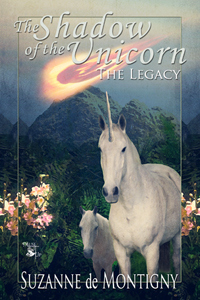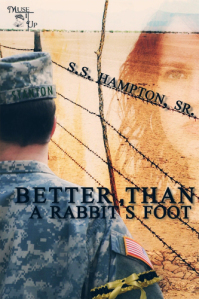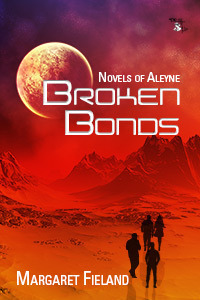Sara Jayne Townsend's Blog, page 21
May 11, 2014
Monday’s Friend: Suzanne de Montigny
Today I am pleased to welcome fellow Muse author Suzanne de Montigny to the blog.
SJT: What advice would you pass on to beginner writers that you wish someone had told you when you were first starting out?
 SdM: Get followers for your FB page, twitter, Google+, and Goodreads now. Don’t wait until the last minute. You need to have those people know you have a book coming out.
SdM: Get followers for your FB page, twitter, Google+, and Goodreads now. Don’t wait until the last minute. You need to have those people know you have a book coming out.
SJT: Who would you cite as your influences?
SdM: Well, it’s hard to say, really. I guess Lucie Maude Montgomery and Kit Pearson.
SJT: Your biography says your writing career was born out of a passion for unicorns. What is it about unicorns that draws you to them?
SdM: Well, my writing career didn’t really come from my unicorns other than that my first project was an extension of my childhood unicorn story. It was actually my father’s death that filled me with a tremendous need to write. And I’ve simply never stopped. I love writing. It takes me away. I love living in the worlds I create. As to why I’m drawn to unicorns? I loved horses as a child and loved to write about them.
SJT: It was while you were a teacher that you discovered that you had a knack for telling stories to children. Have you ever put any of your former pupils in any of your stories?
SdM: No, not really. However, I have named a lot of characters after children I have known. For example, one of my girl unicorns was named after a little girl my son had a crush on in grade one. Two other girl characters were named after my nieces in Australia.
SJT: Tell us about your latest release.
SdM: I am just putting the finishing touches on my second Shadow of the Unicorn novel. This one is called The Shadow of the Unicorn: The Deception. It happens sixty years after the first one, when the Legacy of Azaria has been twisted about by a corrupt leader. When Ulysees and Teo rebel against him, they travel down an old trail where they’re discovered by humans. Hence the fun begins. The nice part about this book is that they find Darius the seer again, plus there is another cataclysmic event that happens.
SJT: What’s the next writing project in the works for you?
SdM: As soon as I’m done with this, I’m going to rehash my teen novel, A Town Bewitched about a child prodigy in classical violin growing up in the small town of Hope. When a red-headed fiddler bewitches the town with her mysterious Celtic music, only Kira knows who’s been vandalising the town leaving dead and gutted birds as a calling card. I recently received the wonderful news that this manuscript won first prize in the Chanticleer competetition, so I’m looking forward to submitting it.
SHADOW OF THE UNICORN: THE LEGACY
Suzanne de Montigny is the author of the award winning Middle Grade novel, The Shadow of the Unicorn: The Legacy.
Blurb:
A loud, hissing sound filled the air. The unicorns looked up, their eyes filled with horror.
Azaria, a unicorn colt, is intrigued when the young, clairvoyant dinosaur, Darius, foresees a terrifying change to their world. When a giant fireball smashes into the earth, the unicorns struggle to survive the hurricanes and starvation that follow. But nothing compares to the danger when the creatures-that-walk-on-two-legs settle in the valley, and their leader discovers the healing power in the unicorns’ horns. Greedy and ruthless, Ishmael will stop at nothing in his pursuit of wealth – even the complete extinction of the herd. Azaria must find a way to outsmart Ishmael before it’s too late.
BUY LINKS:
Amazon
Kobo
MuseItUp Publishing
Barnes and Noble
Smashwords
iBooks


May 5, 2014
Monday’s Friend: Christopher Mannino
Today I am pleased to welcome fellow MuseItUp author Christopher Mannino to the blog.
SJT: When did you first know you were destined to be a writer?
CM: I was a lonely child in elementary school. I probably had more friends in the fiction I read than in real life. During my summer I would stay up for hours reading book after book, sometimes devouring multiple books in a single day. One of my earliest dreams was to become a writer, and transform my love of reading into a means to share dreams and ideas.
SJT: Who would you cite as your influences?
CM: My biggest influences would be J.R.R. Tolkien, JK Rowling, Philip Pullman, and Terry Pratchett.
SJT: What advice would you pass on to beginner writers that you wish someone had told you when you were first starting out?
CM: Another writer I knew once told me “What do you call a writer who never gives up? Answer: published.” To put it simply, writing takes an enormous amount of perseverance and patience. Never stop writing, never lose faith in yourself, and never be afraid to dream big.
SJT: When it comes to your writing projects, would you describe yourself as a meticulous planner, or a ‘seat-of-the-pantser’?
CM: I am in between these two extremes. I start with an idea. I have an entire notebook filled with ideas and scenarios for about 20 novels in multiple genres. Just last week I came up with a new idea for a novel, yet at the moment have other works in progress so I added the idea to my notebook and set it aside for now. Once it’s time to develop an idea, I start by sketching out on pencil and paper, exactly where I want my book to go. I then use a word document to create a rough outline of about three pages or so. Once that amount of planning is done, I free write, and let the novels take its own course, adjusting my plan as I go, and letting the characters develop in their own ways.
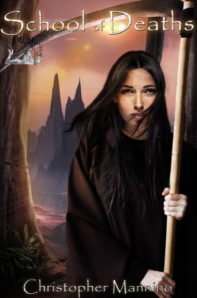 The idea for SCHOOL OF DEATHS emerged when I was finishing my graduate degree at Oxford University. I spent four months abroad, far from everyone I knew. Every week, I traveled somewhere I had never been before. I would climb castle ruins in Wales and visit cathedrals in England. One of my favorite trips was to Tintagel Castle in Cornwall. I crept to the cliff face of Barras Nose, a stony peninsula jutting into the North Sea and overlooking the ruins of Tintagel, which some believe to be the birthplace of King Arthur. It was dawn, there were no other people in sight, and I had to struggle against the wind, fighting to keep my balance so I didn’t crash into the ocean. I imagined being buffeted by winds, alone, and what that would do to a character, and came up with the character of Suzie, alone in a world of men, buffeted by sexism.
The idea for SCHOOL OF DEATHS emerged when I was finishing my graduate degree at Oxford University. I spent four months abroad, far from everyone I knew. Every week, I traveled somewhere I had never been before. I would climb castle ruins in Wales and visit cathedrals in England. One of my favorite trips was to Tintagel Castle in Cornwall. I crept to the cliff face of Barras Nose, a stony peninsula jutting into the North Sea and overlooking the ruins of Tintagel, which some believe to be the birthplace of King Arthur. It was dawn, there were no other people in sight, and I had to struggle against the wind, fighting to keep my balance so I didn’t crash into the ocean. I imagined being buffeted by winds, alone, and what that would do to a character, and came up with the character of Suzie, alone in a world of men, buffeted by sexism.
SJT: Tell us about your new release.
CM: Here’s the blurb for SCHOOL OF DEATHS:
Can a timid girl find bravery as the first female Death?
Thirteen-year-old Suzie Sarnio always believed the Grim Reaper was a fairy tale image of a skeleton with a scythe. Now, forced to enter the College of Deaths, she finds herself training to bring souls from the Living World to the Hereafter. The task is demanding enough, but as the only female in the all-male College, she quickly becomes a target. Attacked by both classmates and strangers, Suzie is alone in a world where even her teachers want her to fail.
Caught in the middle of a plot to overthrow the World of Deaths, Suzie must uncover the reason she’s been brought there: the first female Death in a million years.
SCHOOL OF DEATHS, a YA Fantasy novel, will be released by MuseitUp Publishing as an ebook on May 2nd.
SJT: You write books for adults as well as for teenagers. Is there a difference between the teenage fiction market and the adult fiction market?
CM: I do plan to write adult books in the future, and yes there is a difference between teenage markets and adult. For me, writing for adults is actually more challenging. I spend almost every day with teenagers, as I am a high school theatre teacher. At times, I forget how to interact with other adults, since I am so used to interacting with teens. Aside from obvious content differences, the biggest challenge is writing a book that will appeal to teenagers or to any audience. Once your audience is in mind, you know who the book should be marketed towards.
SJT: What are you working on right now?
CM: At the moment, I am working on a sequel to SCHOOL OF DEATHS titled SSWORD OF DEATHS.
SJT: Thanks for talking to me, Christopher, and good luck with the new book!
AUTHOR BIO:
Christopher Mannino’s life is best described as an unending creative outlet. He teaches high school theatre in Greenbelt, Maryland. In addition to his daily drama classes, he runs several after-school performance/production drama groups. He spends his summers writing and singing. Mannino holds a Master of Arts in Theatre Education from Catholic University, and has studied mythology and literature both in America and at Oxford University. His work with young people helped inspire him to write young adult fantasy, although it was his love of reading that truly brought his writing to life.
Find Christopher online at the following links:
Website
Blog
Goodreads
Twitter
Facebook
Buy Links:
MuseitUp Publishing
Barnes and Noble
Amazon


May 2, 2014
Friday Fears: Two Sentence Horror #2
Well I set up this ‘weekly feature’ some time ago, and it seems to have become a ‘monthly feature’. Sorry about that.
Let’s try and get back on track. With the first post, I invited people to join me in writing two-sentence horror stories and I had two people respond with their own stories. I am showcasing them here.
Friday Fear #2
By Rosie
I was alone in the house. Suddenly a blood curdling scream came from the kitchen.
Friday Fear #3
By Ailitha
The creature’s maw dripped acid, burning the leaves on the forest floor. It came closer.
And finally, I would like to add my own contribution to this episode of Friday Fears
Friday Fear #4
By Sara Jayne Townsend
When I took my dog for a walk through the church yard, he stopped at a grave and began to whine. When I stooped to fetch him, I saw my own name carved into the gravestone.
If you think you can do better, send me your own two sentence horror story and I’ll feature it next time.
Have a good weekend everyone, and don’t have nightmares…


April 30, 2014
Cover Reveal for DEATH SCENE Re-release
(Cross-posted on the WriteClub blog)
At last I can reveal the cover for the MuseItUp re-release of DEATH SCENE. And doesn’t it look fab? With this book being a re-release, the question of what to do with the cover seemed to be more problematic than the first time around. The first cover was much simpler – the comedy/tragedy masks on a black background, with a backdrop of red theatre curtains. I was very pleased with that cover.
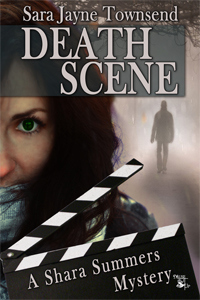 But this time around, I wanted something a bit different. I wanted an image of my main character on the cover. I wanted something to suggest ‘action’ and ‘mystery’, and yet still wanted to suggest the theatrical nature of my amateur sleuth’s main profession. This cover, by the fabulous Charlotte Volnek, does all of this and more.
But this time around, I wanted something a bit different. I wanted an image of my main character on the cover. I wanted something to suggest ‘action’ and ‘mystery’, and yet still wanted to suggest the theatrical nature of my amateur sleuth’s main profession. This cover, by the fabulous Charlotte Volnek, does all of this and more.
And for the first time, Shara appears on the cover of a book. I will say that this image is now how I initially pictured her. But it seems somehow right, and I love it. Here she looks mysterious and sort of ordinary, and that really fits the character. She also has, here, a passing resemblance to the model on the original covers of Sara Paretsky’s V.I. Warshawski series. And since Shara was inspired by V.I. Warshawski, that fits too.
This may not have been how I imagined Shara when I wrote the first two books about her. But it’s how I’m going to see her from now on, and it’s how I’ll picture her when I write the next book.
Release date for DEATH SCENE not confirmed, but it’s looking likely to be June some time. And at present, I’m busy lining up blog tours.
In the meantime, I’m knee deep in edits for both Shara books. So I’d best get to it.


April 28, 2014
Monday’s Friend: Stan Hampton Sr
Today my guest is MuseItUp author Stan Hampton Sr, whose real-life stories are as interesting as his fictional ones. And he’s going to tell us one. Welcome, Stan!
The Writing Life
By Stan Hampton Sr.
Good morning fellow writer, and reader.
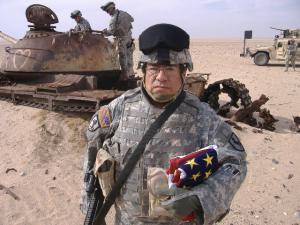 It is Sunday morning. After a little over two years of officially being a homeless Iraq War veteran, and living in a small complex for homeless veterans next to one of Las Vegas’ major homeless corridors, I am now living several miles away in a weekly—that is a cross between an apartment and a motel, and bureaucratically speaking is considered one step above homelessness. I am making breakfast for myself and one of my children who is now living with me because they are separated from their spouse. And I have to take my 16-year old car for a fluid check before getting an oil change next month, and then today with my grandchildren from that now sundered marriage, I have to do a lot of photography to catch up on classes and meet current deadlines so that I can finally graduate with an Associates in Photography. And double-check the account of a bank I despise because I do not have a job and am living off of a Pell Grant and student loans until my monthly retirement pay starts, plus using the funds for my photography expenses—talk about being in a neck-to-neck race. And somewhere in all of this, get in some more editing on my second novel so I can submit that to my publisher (my publisher and I still haven’t completed the edits on my first novel).
It is Sunday morning. After a little over two years of officially being a homeless Iraq War veteran, and living in a small complex for homeless veterans next to one of Las Vegas’ major homeless corridors, I am now living several miles away in a weekly—that is a cross between an apartment and a motel, and bureaucratically speaking is considered one step above homelessness. I am making breakfast for myself and one of my children who is now living with me because they are separated from their spouse. And I have to take my 16-year old car for a fluid check before getting an oil change next month, and then today with my grandchildren from that now sundered marriage, I have to do a lot of photography to catch up on classes and meet current deadlines so that I can finally graduate with an Associates in Photography. And double-check the account of a bank I despise because I do not have a job and am living off of a Pell Grant and student loans until my monthly retirement pay starts, plus using the funds for my photography expenses—talk about being in a neck-to-neck race. And somewhere in all of this, get in some more editing on my second novel so I can submit that to my publisher (my publisher and I still haven’t completed the edits on my first novel).
And…
No, I think that is it.
So, what does all of this have to do with The Writing Life?
Ah, well, I am not sure. But let us take a look at this together.
I have wanted to be a writer since I was 15 years old. Of course, once I saw a documentary about photographers that included a guy photographing a bikini-clad woman dancing on a beach, I wanted to do that too.
I became an Army-trained photographer. No bikini-clad women dancing on a beach there—there was sitting in the doorway of a Huey helicopter with my boots on the skids, and leaning out to get a vertical photograph during a training mission. And one time, in real-life, standing with one boot on the wall of a Chinook helicopter and one boot on the floor, leaning over the open side door to photograph a military airplane crash in which two people died.
There were good times though. Being stationed in Europe for five years provided plenty of photographic opportunity, not to mention 13 years in Colorado Springs.
But, I was 38 years old before my first fiction writing was published. Another 10 years passed before my second writing was published. Since 2002, the number of publishing credits have climbed until my first novel was accepted for publication later this year. (I dislike editing, and editing a novel takes so long compared to short stories and novellas.)
Life has been challenging for me, as I am sure it has been for many of you.
My point is, do not give up. Prioritize and keep going—this may be difficult, but if you believe in yourself, and you have stories to tell, do not give up. If anything, observe everything around you, even when times are difficult. There is no telling when your observations and emotions can be worked into your writing. And if you keep working at your craft, you will find a publisher who also believes in you.
But do not expect to get rich overnight. Very few do. Finding some financial success requires a lot of marketing, a lot of public relations. But, do not give up.
Oh, yeah—if you promise someone a blog submission and say you will have it to them no later than 10 days before the blog date, prioritize. Ensure you meet that goal. No matter what the circumstances, do not wait until the day before. Yeah.
And, hi Sara-Jayne. Here is my submission. Thank you for the opportunity. You, and everyone, have a great week!
“Better Than a Rabbit’s Foot.”
Ed. Joelle Walker. MuseItUp Publishing, June 2012.
ISBN: 978-1-77127-078-6
BLURB:
Sergeant Jerry Stanton is a young soldier serving in the War in Iraq. He is a gunner on a gun truck nicknamed “Lucky Bear,” one of those tireless workhorses that escort supply convoys from camps in Kuwait to destinations scattered throughout the war-torn country. In the early morning hours before a scheduled mission, a dust storm howls across his camp and threatens to bring convoy operations to a halt. Worse, the camp receives word that a gunner from his company was killed by an IED while on a convoy mission. Unlike most soldiers, Jerry doesn’t carry a lucky charm, but upon receiving news of the death of the gunner, he begins to mull over/ponder the merit/virtue of a good luck charm—only, what would work for him? Perhaps mail call will provide the answer.
EXCERPT:
“People like a happy ending.”
Sergeant Jerry Stanton, an M4 Carbine slung across his chest, glanced at the dark form that trudged alongside him in the hot, early morning darkness. It was all the darker for the dust storm howling across the small camp, a dusty and sandy convoy support center, CSC, a mile south of the Iraqi border. He placed his hand over the tall styrofoam coffee cup from the messhall that was open at all hours to serve those about to head out on a mission. He felt the itchy dust filtering down his back, along his arms, and coating his fingers.
In spite of his short time deployed to Kuwait, he had learned that dust storms were worse than sand storms; they were hot and itchy while the sand storms stung exposed skin and chilled the air. Breakfast was good but tasted flat, more due to the question of whether their mission would be a go or no-go because of the storm that roared out of the midnight darkness hours before.
“What?”
“People like a happy ending,” the soldier repeated. He was a gunner from another gun truck as the squat, venerable M1114 HMMWVs, which were never meant to be combat vehicles, were called. He held up a rabbit foot that spun frantically in the wind and added, “I like a happy ending. Especially now.” They rounded the corner of a small building, actually a renovated mobile home trailer with a covered wooden porch lit by a bare electric bulb. The gunner pointed to a small black flag, suspended from a log overhang, flapping furiously in the wind.
“Oh shit.” Jerry sighed as a cold chill raced through him.
“It’s been there for an hour or so,” the soldier said as he enclosed the rabbit’s foot within both hands and brought it up to his lips as if to kiss it. He glanced at Jerry. “I’m not superstitious, but still, I mean, there’s nothing wrong with having a lucky charm. You know?”
“Yeah.” Jerry nodded as he watched the twisting flag. “I know.”
The soldier looked once more at the black flag and then walked toward the shower and restroom trailers beyond which were the air-conditioned sleeping tents they called home…
Available from MuseItUp Publishing
AUTHOR BIO:
SS Hampton, Sr. is a full-blood Choctaw of the Choctaw Nation of Oklahoma, a divorced grandfather to 13 wonderful grandchildren, and a published photographer and photojournalist. He retired on 1 July 2013 from the Army National Guard with the rank of Sergeant First Class; he previously served in the active duty Army (1974-1985), the Army Individual Ready Reserve (1985-1995) (mobilized for the Persian Gulf War), and enlisted in the Army National Guard in October 2004, after which he was mobilized for Federal active duty for almost three years. Hampton is a veteran of Operations Noble Eagle (2004-2006) and Iraqi Freedom (2006-2007). His writings have appeared as stand-alone stories and in anthologies from Dark Opus Press, Edge Science Fiction & Fantasy, Melange Books, Musa Publishing, MuseItUp Publishing, Ravenous Romance, and as stand-alone stories in Horror Bound Magazine, The Harrow, and River Walk Journal, among others. Second-career goals include becoming a painter and studying for a degree in photography and anthropology—hopefully to someday work in and photograph underwater archaeology. After 12 years of brown desert in the Southwest and overseas, he misses the Rocky Mountains, yellow aspens in the fall, running rivers, and a warm fireplace during snowy winters. As of April 2014 in Las Vegas, Nevada, Hampton is officially no longer a homeless Iraq War veteran.
Melange Books
http://www.melange-books.com/authors/sshampton/index.html
Musa Publishing
http://www.musapublishing.com/index.php?main_page=index&manufacturers_id=50
MuseItUp Publishing
Amazon.com Author Page
http://www.amazon.com/SS-Hampton-Sr/e/B00BJ9EVKQ
Amazon.com. UK Author Page
http://www.amazon.co.uk/SS-Hampton-Sr/e/B00BJ9EVKQ
Goodreads Author Page
http://www.goodreads.com/author/show/6888342.S_S_Hampton_Sr_


April 21, 2014
Monday’s Friend: Marsha R West
Today I’m pleased to have fellow MUI author Marsha R West on the blog, on the day she’s revealing her new cover! Welcome, Marsha!
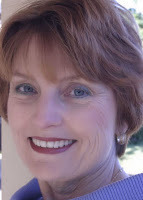 SJT: Which writers have inspired your own writing?
SJT: Which writers have inspired your own writing?
MW: I’d have to say Carla Neggars. I’ve loved her series about the families in the New Hampshire White Mountains that she intertwined with the family in Tennessee. I love her descriptions and think she’s brilliant the way she keeps all the pieces together. Setting plays a big role in her books, and I usually begin with the setting. My first two books are stand-alones, but I’ve sold the first book in a series.
SJT: What advice would you pass on to beginner writers that you wish someone had told you when you were first starting out?
MW: Well, I’m very glad no one told me how hard the job was. I might not have begun the journey. :) I guess I wish someone had pointed me to classes sooner. I know of people who took on-line classes before ever beginning a book. I made many mistakes with the first two books I wrote that I could’ve avoided. Of course, it’s definitely a learn by doing job! Some stuff I don’t think I’d have understood if it had been presented before I was ready.
SJT: You’ve been a high school theatre teacher. I absolutely loved my drama class when I was in high school and for a while harboured a fantasy of becoming a famous actress. Did you ever teach anyone who went on to become a famous?
MW: I had a student who went on to work in the business as a stunt double, especially for children. And one of my students became a theatre teacher herself. That I think is very cool.
SJT: Your bio says you own dogs (or perhaps, more accurately, they own you). I feel the same way about my cats. Do you think there’s a difference between ‘dog people’ and ‘cat people’?
MW: In actual fact, we lost both our puppies last summer. Simon died one week and the next week my first book came out, and the third week we lost Scout. Very sad time :( mixed with the joy of the book release. Basically, I cried every day for six months.
I’m a dog person, but I know folks who have both. I just don’t see how the connection can be the same between the two. Dogs give you unconditional love. Cats seem to have a take it or leave it attitude with their parents. But I’ve never had a cat, so I could be misreading the signs.
I do think that all animal lovers are basically good people as opposed to someone who doesn’t like animals. Animal abuse is committed by some of the lowest of the low in creation!
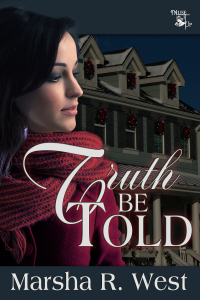 SJT: Tell us about your new book.
SJT: Tell us about your new book.
MW: The short tag for TRUTH BE TOLD is: SWAT member teams with brother’s former LA homicide detective partner to stop a blackmailer. Falling in love wasn’t one of their strategies.
Of course, it’s more complicated than that. The blackmailed person is Meg’s father, the mayor of Fort Worth. Her brother’s partner, Scott, was medically retired from the force when he nearly lost his life saving her brother’s. Scott struggles against the attraction he feels for Meg, who couldn’t possibly find anything of interest in him when he can’t walk without his cane and has no clue what shape his life will take. And all the while the blackmailer inserts himself into the family’s life. Will he succeed in killing one of them before they can stop him?
TRUTH BE TOLD releases next month.
SJT: What’s next for you, writing-wise?
MW: I’ve returned to my theatre roots for the third book, SECOND CHANCES, which I just sold to MuseItUp Publishing. When a member of the board of a non-profit arts agency turns up dead, the homicide detective assigned to the case looks at everyone involved in the organization, including the Executive Director. This book is scheduled for e-release in the winter of 2014/15. It’s the first of several about four women friends all in their mid-forties who struggle to protect their families from the dangers stalking them. They are surprised when it appears they might stumble into a second chance at love.
SJT: What do you like to do when you’re not writing?
I confess I’m a huge TV junky. Thanks goodness for the record button. I even record House Hunters on HGTV. I love being able to skim through the commercials. Saves me a ton of time.
Reading and Travel are high on my list of things to do when not writing. DH and I love to go to New England especially Maine, which is where my current Work in Progress is set. It’s the second in the series, but I’m only about a fourth of the way through.
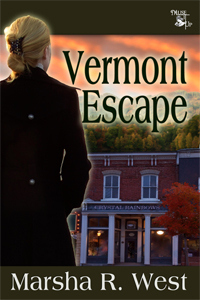 VERMONT ESCAPE can be found at.
VERMONT ESCAPE can be found at.
MuseItUp Publishing
B & N
Amazon
BLURB:
Two years after the murder of her husband, someone guns down Jill Barlow’s father, a Texas State Representative. The authorities suspect a connection between the murders, but can’t find proof. Jill longs for the peace she found when she visited Vermont after her husband’s death. With the perpetrators still at large, she flees to the small town of Woodstock.
The gambling syndicate, believing she has damning evidence against them, pursues her, shattering her dreams of peace. In an effort to protect her grown children, she doesn’t tell them violence continues to stalk the family.
Despite having lost so much already, with the lives of her family and friends at stake, will Jill be required to make more sacrifices, even the hope of a second chance at love?
AUTHOR BIO
Marsha R. West, a retired elementary school principal, is also a former school board member and theatre arts teacher. She writes romantic suspense where experience is required. Her heroes and heroines, struggling with life and loss, are surprised to discover second chances at love.
Marsha, who loves to travel, lives in Texas with her supportive lawyer husband. They’ve raised two daughters who’ve presented them with three delightful grandchildren.
Marsha’s current WIP is another romantic suspense. It’s the second of a planned series about four women who met when they were kids at summer camp.
You can read her blog Thoughts on Thursday and Tuesday Author Chats at http://www.marsharwest.com/category/blog
She hopes you’ll stop by. She’d love to hear from you.
Social Links
Blog for Thoughts on Thursday and Tuesday Author Chats
Facebook
Twitter
Thanks so much for having me today, Sara Jayne.


April 16, 2014
The Further Adventures of Shara Summers
(Cross-posted on the WriteClub blog)
My editor at MuseItUp has been quite busy. Not only have I received the second round of edits on DEATH SCENE from her, I’ve also received the first round of DEAD COOL edits.
As well as meaning I know what I’ll be doing for the Easter weekend, it makes the whole thing a bit more real. DEATH SCENE is scheduled for release next month. DEAD COOL will follow a few months later.
This is all very exciting stuff, particularly with a series that I had pretty much given up on completely at one point (and if you’re a recent visitor to this blog, do a search on the Shara Summers tag to get a better idea of what I’m talking about here). Shara now has a home with MuseItUp. And with the contract for DEAD COOL stating that they want first refusal of any sequel, it makes writing more Shara books an attractive prospect. When I thought I was writing the second book of a series that no one was going to buy, I found it a bit discouraging to carry on with it.
The homage to Agatha Christie’s AND THEN THERE WERE NONE, which I started writing as the original sequel to DEATH SCENE and then gave up halfway through, I am now giving serious thought to reviving as the third book in the Shara series. This one originally suffered from lack of plotting, when I got stuck halfway through and abandoned because I made the mistake of starting to write the book without working out first how it was going to end.
The thing is, though, there was a publisher last year I sent DEAD COOL to and it got a very enthusiastic response from the editor there. So much so that she asked questions about the first book, and the third, and at one point we were talking about a three book deal.
Sadly in the end this did not lead to a deal – not because of the editor, who remained enthusiastic, but apparently she could not convince her sales people that there was a market for a contemporary British-based Amateur sleuth in the US, and the US was too big a market for them to overlook this. And that’s a whole different topic – let’s not go there.
The point of mentioning this is that when this editor asked me for a plot summary of Book 3, as part of her negotiations with the marketing people, I had to come up with one quickly. This obliged me to go back to my half-finished novel and decide how it was going to end. This plot summary is something I now do as a matter of course (see last week’s post on Plotting), but at the time I started this manuscript I didn’t, and it became one of the many casualties I abandoned halfway through before I learned the valuable lesson about how important it is to plot.
Anyway, the point of this rather roundabout tale is that because of this sequence of events I now have a complete plot outline for the next Shara book. And I’m starting to feel increasingly enthusiastic about writing this book.
There are other, less developed ideas as well for other Shara books. I want to take her back to New York (where she starts out in the opening scene of DEATH SCENE), in a story that will involve a secondary character in DEAD COOL (no spoilers!). So maybe that’s book 4.
On the first round, Shara didn’t reach a very big audience. But there are a handful of loyal fans out there who are interested in what happens to her next.
When one of them happens to be your editor, it does renew your faith in your character.


April 9, 2014
Plotting
(Cross-posted on the WriteClub blog)
On the crime panel at Sci Fi Weekender, I found myself – quite literally – between two opposing views on plotting. At one end of the table was a writer who was evangelical about the importance of plotting. At the other end of the table was a writer who says she never plots and believes she would lose interest in writing about her characters if she knew what was going to happen to them next. I was sitting in the middle.
I was struck by how neatly this set up demonstrated opposing views on plotting. Some writers are plotters, some are ‘seat of pantsers’, but rarely have I seen two extremes demonstrated so neatly on the same panel. And it inspired me to come up with this post.
I am on the side of the plotters, I have to say. But it hasn’t always been that way, and it has been my own experience that has brought me to this way of thinking.
When I started writing SUFFER THE CHILDREN, it was based on a short story called “Kiddiwinks”. The story was basically about a group of children telling scary stories to each other about the witch that allegedly lives in the haunted house. They dare each other to go in and discover that it is, indeed, occupied by a sinister old woman. Who, they learn too late, eats children. The writing group encouraged me to turn this short story into a novel, and the premise behind SUFFER THE CHILDREN was born.
When I began the novel I knew the monster was to be a mythological creature, and that the main characters would have to defeat the creature. What I didn’t know at the time was how they were going to do that. I began the first draft, thinking that ideas would come to me as I went along. I ended up writing half the novel, and then got stuck. I went back to the beginning, and re-wrote the first half, but I was still stuck at the same point. My characters were floundering around saying that they had to defeat this evil creature, but they had no idea how to do it, and neither did I. I put the novel away, for a good five years – writing short stories in the mean time. I dreaded going back to it. I had no idea how I was going to write myself out of the hole I’d dug for myself.
But I wanted to finish the novel, and eventually I bit the bullet and realised I had to work out how it was going to end. So I went back to the beginning and wrote a three-page summary of the whole novel. From there I took that summary and broke it down into a chapter by chapter plan, from beginning to end.
At that point, I went back and started the novel over. And lo and behold I got to the end of the first draft.
I have used this technique for writing ever since. I write the plot summary first - usually it runs to three pages. I break that down into a chapter by chapter outline. Only then do I start writing the first draft.
Some people baulk at such a regimented plan, but this is now the only way I can write a novel. It means that every time I sit down for a writing session, I review what I wrote last time, and I look at my chapter plan and I know what’s going to happen next. Sometimes my chapter plan is quite brief – it might say, for instance, that in chapter 10 my amateur sleuth has to discover X about this character, which turns out to be a vital clue. But how she’s going to discover this piece of information I still have to think about when I sit down to write the chapter.
This doesn’t mean that things always go to plan. Writing the first draft of DEAD COOL I was surprised to discover about three quarters of the way through the first draft that the killer was not who I initially thought it was. But knowing the identity of the real killer suddenly made a lot of things in the plot that hadn’t been making sense click into place, and all I actually had to do to correct the second draft was to plant a couple of extra clues and rewrite a few scenes with different characters. And of course it did change the ending a bit.
If you’re a pantser and not a plotter, I am not disrespecting the way you work. Everyone has to find the system that works for them. But I will say, as a reader, I can tell when a book has not been plotted. Generally the book will start off with the characters heading in a certain direction, and suddenly they’ll lurch off and head in a completely different direction. Some people might say that they enjoy unexpected twists like this, but I tend to find them a bit off-putting. But this is just me. On the whole, I don’t like surprises.
Perhaps we can liken writing a novel to taking a journey. A plotter takes the GPS, and the map. They’ve studied the route beforehand, they know where they are going and how they are going to get there. There are no surprises. This is the way I work. Occasionally I might take a slightly different road than the GPS suggests, because instinct suggests there’s a better way, but only if I’m confident that I’m still going to end up in the same place.
A pantser, on the other hand, will get in the car and start driving. For them, it’s about the journey, not the destination. They will get lost, they will arrive very late, they might end up someplace completely unexpected, but they enjoy the journey and not knowing what’s around the next corner.
Plotting and pantsing is reflected in reading preferences, too. I much prefer to read books that are plot driven, with a clear beginning, middle and end. Readers who are more fond of character-driven books and ‘surprises’ are going to be more fond of writers who don’t plot. And I suspect such readers may not get on very well with my books – they might consider them too predictable.
This is one of those issues that always causes lively debate – there’s no right or wrong answer, it’s entirely down to personal preference. Whether you’re a reader, or a writer, where do you stand?


April 7, 2014
Monday’s Friend: Margaret Fieland
Today I am pleased to have fellow MuseItUp author Margaret Fieland as my guest. Welcome, Margaret!
SJT: When did you first know you were destined to be a writer?
 MF: LOL, I never realized I was destined to be a writer – I fell into it. I’d written poetry for years, collecting it in notebooks stacked in my attic when I wrote one I wanted to keep. This led me to several online sites and ultimately to discovering the Muse Online Writers Conference where I hooked up with Linda Barnett Johnson and joined her writers forums. She required everyone to write both fiction and poetry, so, with much trepidation, I started writing fiction. Then I got hooked on it, wrote a chapter book, took the ICL course and actually learned how to write it. Then in 2010, I was seized by a desire to write a sci fi novel, so I spent six weeks or so on world building, mostly, with a bit of plotting thrown in for good measure.
MF: LOL, I never realized I was destined to be a writer – I fell into it. I’d written poetry for years, collecting it in notebooks stacked in my attic when I wrote one I wanted to keep. This led me to several online sites and ultimately to discovering the Muse Online Writers Conference where I hooked up with Linda Barnett Johnson and joined her writers forums. She required everyone to write both fiction and poetry, so, with much trepidation, I started writing fiction. Then I got hooked on it, wrote a chapter book, took the ICL course and actually learned how to write it. Then in 2010, I was seized by a desire to write a sci fi novel, so I spent six weeks or so on world building, mostly, with a bit of plotting thrown in for good measure.
SJT: Who would you cite as your influences?
MF: I’m a way-back sci-fi fan, and Robert A. Heinlein influenced me heavily. I took a lot away from his writing, notably the value of surprising one’s reader. I also love Lewis Carroll, both his Alice books and his poetry. I can still recite several stanzas of Jabberwocky from memory. Isaac Asimov and James M. Barrie are also early influences.
SJT: What advice would you pass on to beginner writers that you wish someone had told you when you were first starting out?
MF: Don’t let your vision of yourself as a writer be limited. I never, other than for English class, wrote a word of fiction before I joined Linda’s writing forums. It simply never occurred to me that I could – or that I wanted to. A clear failure of imagination.
SJT: You bio says you read a lot of science fiction aimed at boys when you were growing up. There is a myth out there that science fiction is written by, and for, men. Do you think any progress has been made in the last few years about raising public awareness that women write, and read, science fiction?
MF: Well, there is certainly lots more sci fi written by women now-a-days, and I do believe more women are reading the genre. But there were actually women sci fi writers when I was growing up – Andre Norton and C.L. Moore, to name a couple. Do notice, however, the androgynous names. Things have indeed improved a bit since then. But I do believe that sci fi is viewed as a largely male preserve, just like, sadly, computer software engineering.
SJT: Where do think the human race will be a hundred years from now – utopia, dystopia, or the same place we are now?
MF: About the same place we are now, truthfully. However, from a writers’ point of view, this is probably the least interesting alternative {grin}, so my writing certainly won’t reflect this rather mundane view of our future. As a writer, predicting disaster of one kind or another is a much more fruitful source. In my Aleyne novels, the backstory includes a collapse of technology here on Earth in about 100 years, due to riots that brought down the government and destroyed infrastructure.
SJT: Tell us about your latest release.
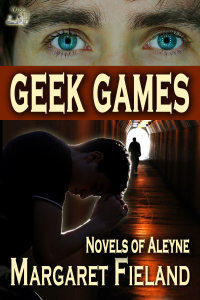 MF: The latest release was Geek Games, which is actually the second Aleyne novel, in terms of chronology. It features a fourteen-year-old main character, Martin Samuels, who foolishly brings down the spaceport computer network, thus enabling the terrorists to set off a bomb which kills his friend’s father. The third novel in the series, Broken Bonds, was released in July. It features Brad Reynolds, who is the Major in charge of the Federation Guard base on Aleyne. It takes place roughly four years after Geek Games.
MF: The latest release was Geek Games, which is actually the second Aleyne novel, in terms of chronology. It features a fourteen-year-old main character, Martin Samuels, who foolishly brings down the spaceport computer network, thus enabling the terrorists to set off a bomb which kills his friend’s father. The third novel in the series, Broken Bonds, was released in July. It features Brad Reynolds, who is the Major in charge of the Federation Guard base on Aleyne. It takes place roughly four years after Geek Games.
SJT: What are you working on at present?
I’m finishing up the fourth book in the series. It’s another adult novel, a sci fi action-adventure romance, and the main character is Colonel Robert Walker, the man who (spoiler) arrests Brad for treason in Broken Bonds. I’ve been calling it Rob’s Book as a working title, but I’m going to have to get busy soon and pick out a real one.
I also just started plotting out a fantasy. It takes place some unknown hundreds of years in the future where we’re experiencing another ice age. My main character and his clan are living in caves.
Author Bio:
Born and raised in New York City, Margaret Fieland has been around art and music all her life. Her poems and stories have appeared in journals such as Turbulence Magazine, Front Range Review, and All Rights Reserved. She is one of the Poetic Muselings. Their poetry anthology, Lifelines, was published by Inkspotter Publishing in November, 2011. She is the author of Relocated, Geek Games, and Broken Bonds, published by MuseItUp Publishing, and of Sand in the Desert, a collection of science fiction persona poems. A chapter book is due out later this year.
Find Margaret online at the following links:
Pinterest
Facebook
Twitter
Goodreads
Sex with aliens? How about romance with aliens? A treason accusation? Brad Reynolds has his hands full. When Major Brad Reynolds is assigned to head the Terran Federation base on planet Aleyne, the last thing he expects to find is love, and certainly not with one of the alien Aleyni. How can he keep his lover, in the face of political maneuvering and of Ardaval’s feelings for his former partners — and theirs for him?
Buy Links:
Publisher’s website
Amazon
Barnes and Noble
Bookstrand
BLURB for GEEK GAMES
When fourteen-year-old Martin lets Tom, a charismatic bully, persuade him to bring down the spaceport computer network, he never considers someone will place a bomb resulting in the death of his friend’s father. Nothing will bring Captain Frey back, but if Martin can help locate the terrorists’ drug lab, perhaps he’ll be able to forgive himself.
Buy links:
Publisher’s website
Amazon
Omnilit


April 4, 2014
Friday Fears: Two Sentence Horror – An Introduction
Some writers do ‘Friday Flash’, where they present to the world a story of no more than 100 words at the end of the week. I’ve always considered myself not very good at Flash Fiction – I figure I need more than a hundred words to tell a story.
But I recently came across this website featuring horror stories of two sentences.
These snippets are not credited, so I don’t know who wrote them, but I found them to be genuinely creepy. They may be only a few words long, but they stay with you for a long time. And this has inspired me to set this challenge for myself. To write scary stories in two sentences. I think the discipline will be good for me, and it might teach me not to be so afraid of flash fiction.
And so I present a new feature on the blog: Friday Fears – Horror stories in two sentences. On Fridays, I will present a scary story in two sentences. I would like to invite people to join me on this.
So these are the rules. The idea of the story is to creep people out. It can be no more than two sentences. The sentences must be complete – no run-on sentences and blatant disregard of grammar. You can’t use a comma instead of a full stop and expect to get away with it. However, extended sentences and complete multi-phrase sentences are perfectly acceptable.
I invite others to try their own hand at two sentence horror stories. If you want to send me your efforts, I shall offer them on the blog as the next Friday Fear – credited, of course. Let’s see who can write the scariest two-sentence horror story.
As a taster, here is my first attempt.
FRIDAY FEAR #1:
I was alone in the house when I looked into the mirror and saw a pale-faced stranger standing behind me. When I turned around, there was no one there.
Maybe not bad for a first attempt, but I reckon I can do better. I need to get practising.
Happy Friday!



